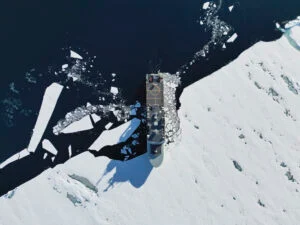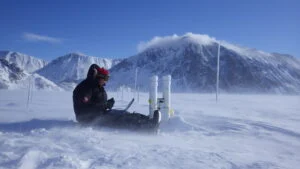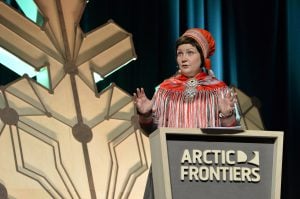
People & Culture
On thin ice: Who “owns” the Arctic?
As the climate heats up, so do talks over land ownership in the Arctic. What does Canadian Arctic Sovereignty look like as the ice melts?
- 4353 words
- 18 minutes
Environment
A multi-year diving expedition led by the Canadian Museum of Nature aims to learn more about the diversity and distribution of seaweed in the Arctic

The chilly waters of Canada’s Arctic may not be the first place you think of when picturing beds of colourful seaweed. But even in this frigid climate, marine plants are thriving and have become the focus of a new multi-year research program that kicked off this past summer.
Launched in August 2022, the purpose of the program is to better understand the diversity and biomass of seaweed in the Arctic while also identifying new species living in icy waters. Led by Amanda Savoie, a taxonomist and research scientist at the Canadian Museum of Nature, and based at the Canadian High Arctic Research Station in Iqaluktuuttiaq (Cambridge Bay), Nunavut, the first five-week field season saw researchers make multiple dives per day to collect specimens and catalogue species present in the area.

“We need to know more about seaweed because it’s a really important part of the marine ecosystem and it’s relatively understudied,” says Savoie. “We don’t know a lot about seaweed biodiversity in Canada and what types of seaweed we have.” In addition to providing habitat for fish, seaweeds are an important source of food for many marine animals, such as the green sea urchin. Many other invertebrates also feed on the detritus produced by kelp and other microalgae, and then fish eat those invertebrates.
The Arctic Ocean is home to massive kelp forests, a fact Savoie says might surprise people who imagine the region is icebound and barren. “Even under the ice in these really cold places, we find these huge beds of kelp.” This past summer was Savoie’s first time scuba diving in the Arctic. She says she wasn’t quite sure what to expect but was blown away by the clarity of the water and the colours of the plant and animal life. Even on dives where not much seaweed was found, other sea life was present, including sea stars, sea cucumbers and anemones.

Savoie fell in love with seaweed after taking a class on the marine plant during her undergraduate studies at the University of New Brunswick and went on to complete a PhD in seaweed taxonomy. “I just love the ocean,” she says. “I love scuba diving and I love studying something that’s relatively under appreciated or understudied.”
While pursuing her research in the Arctic, Savoie has been collaborating with a group from Laval University on a project called ArcticKelp, which is being funded by ArcticNet. While Savoie is interested in all seaweeds and their diversity, the Laval group is particularly interested in kelp, large brown algae that are important, productive and conspicuous parts of the marine ecosystem.
Without prior knowledge of where the seaweed is located, the researchers have been “exploring” by going out on the water, dropping GoPro cameras, then pulling them up to see what is below. If there are signs of seaweed, they will then dive down and collect samples.
With water temperatures ranging from zero to four degrees Celsius, divers wear dry suits to protect themselves against the cold. Because seaweed needs light, the dives are typically only to a depth of about 30 metres. Savoie will then press the seaweed samples to bring back to the museum in Ottawa for further study.
Working with ArcticKelp, Savoie has also been studying seaweed biomass by placing a quadrat (a metal square about 20 by 20 inches) on the seafloor. Everything in the square is then collected and weighed to allow researchers to track changes over the years. “It is important to know both the number of species and the biomass because these are things that can change with climate change,” says Savoie. “New species might come in, and some species might grow more or less. We are trying to find a way to capture that change.”

In the spring of 2022, Savoie also met with community members in Cambridge Bay and the local Hunters and Trappers Organization, where she learned that some members of the community are interested in seaweed as a food source. To incorporate Inuit Qaujimajatuqangit (Inuit traditional knowledge) into the research project, Savoie also plans to spend more time learning from locals about the marine resources in the area.
To date, there are an estimated 175 known species of seaweed in the Canadian Arctic, but Savoie assumes this project will discover new records since the most recent surveys took place more than four decades ago.
In the 1960s and 70s, museum researcher R.K.S. Lee studied seaweed in the Arctic and produced taxonomic surveys. These Arctic specimens are now curated in the museum’s National Herbarium of Canada in Gatineau, Quebec.
“It’s really important for us to understand that Canada has the longest coastline in the world, and most of it is in the Arctic,” says Savoie. “We just know so little about marine ecosystems, and seaweed is just one small part of this puzzle. Even if our team can help to understand just that little part of this puzzle, I think it can be really important and really useful.”
Are you passionate about Canadian geography?
You can support Canadian Geographic in 3 ways:

People & Culture
As the climate heats up, so do talks over land ownership in the Arctic. What does Canadian Arctic Sovereignty look like as the ice melts?

Environment
David Boyd, a Canadian environmental lawyer and UN Special Rapporteur on Human Rights and the Environment, reveals how recognizing the human right to a healthy environment can spur positive action for the planet

Science & Tech
Celebrating Canadian Innovation Week 2023 by spotlighting the people and organizations designing a better future

Environment
The uncertainty and change that's currently disrupting the region dominated the annual meeting's agenda